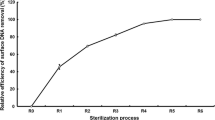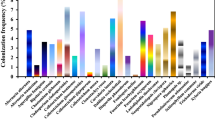Abstract
Endophytes play an important role in the growth and development of the host. However, the study of endophytes is mostly focused on plants and animals, and reports on microorganisms associated with fungus are relatively rare. We studied the microorganisms associated with Tricholoma matsutake fruiting bodies picked from three main T. matsutake-producing areas in Sichuan, China, by both culture-dependent and culture- independent methods. Altogether 13 fungus, 15 yeast and 14 bacterial strains were isolated from the T. matsutake fruiting bodies. The most abundant cultivable fungus, yeast and bacteria isolates were assigned as Fusarium solanis, Cryptococcus sp. and Pseudomonas sp., respectively. Terminal-restriction fragment length polymorphism analysis (T-RFLP) showed that the bacteria in T. matsutake were abundant and diverse. Betaand gamma-proteobacteria, Acidobacteria, Bacteroidetes and Sphingobacterium were found in samples from all collecting sites. Among these bacteria, we may find some strains that can promote the growth of T. matsutake.
Similar content being viewed by others
References
Alvin, A., Miller, K.I., and Neilan, B.A., Exploring the potential of endophytes from medicinal plants as sources of antimycobacterial compounds, Microbiol. Res., 2014, vol. 169, pp. 483–495.
Aschehoug, E.T., Callaway, R.M., Newcombe, G., Tharayil, N., and Chen, S.Y., Fungal endophyte increases the allelopathic effects of an invasive forb, Oecologia, 2014, vol. 175, pp. 285–191.
Azliza, I.N., Hafizi, R., Nurhazrati, M., and Salleh, B., Production of major mycotoxins by Fusarium species isolated from wild grasses in peninsular Malaysia, Sains Malays., 2014, vol. 43, pp. 89–94.
Banhos, E.F., Souza, A.Q.L., Andrade, J.C., Souza, A.D.L., Koolen, H.H.F., and Albuquerque, P.M., Endophytic fungi from Myrcia guianensis at the Brazilian Amazon: distribution and bioactivity, Braz. J. Microbiol., 2014, vol. 45, pp. 153–162.
Bhatia, S.K., Mehta, P.K., Bhatia, R.K., and Bhalla, T.C., Optimization of arylacetonitrilase production from Alcaligenes sp MTCC 10675 and its application in mandelic acid synthesis, Appl. Microbiol. Biotechnol., vol. 98, pp. 83–94.
Chang, P., Gerhardt, K.E., Huang, X.D., Yu, X.M., Glick, B.R., Gerwing, P.D., and Greenberg, B.M., Plant growth-promoting bacteria facilitate the growth of barley and oats in salt-impacted soil: implications for phytoremediation of saline soils, Int. J. Phytoremediat., vol. 16, pp. 1133–1147.
Dudnik, A., Bigler, L., and Dudler, R., Production of proteasome inhibitor syringolin A by the endophyte Rhizobium sp. strain AP16, Appl. Environ. Microbiol., 2014 vol. 80, pp. 3741–3748.
Glaser, K., Kuppardt, A, Krohn, S., Heidtmann, A., Harms, H., and Chatzinotas, A., Primer pairs for the specific environmental detection and T-RFLP analysis of the ubiquitous flagellate taxa Chrysophyceae and Kinetoplastea, J. Microbiol. Methods, 2014, vol. 100, pp. 8–16.
Hazen, T.H., Zhao, L.C., Sahl, J.W., Robinson, G., Harris, A.D., Rasko, D.A., and Johnson, J.K., Characterization of Klebsiella sp. strain 10982, a colonizer of humans that contains novel antibiotic resistance alleles and exhibits genetic similarities to plant and clinical klebsiella isolates, Antimicrob Agents Chemother., 2014, vol. 58, pp. 1879–1888.
Hou, Y.L., Ding, X., Hou, W.R., Zhong, J., Zhu, H.Q., Ma, B.X., Xu, T., and Li, J.H., Anti-microorganism, antitumor, and immune activities of a novel polysaccharide isolated from Tricholoma matsutake, Pharmacogn. Mag., 2013, vol. 9, pp. 244–249.
Iwase, K., Cultivation of mycorrhizal mushrooms, Food Rev. Int., 1997, vol. 13, pp. 431–442.
Jiang, D.M., Cao, C.Y., Zhang, Y., Cui, Z.B., and Han, X.S., Plantations of native shrub species restore soil microbial diversity in the Horqin Sandy Land, northeastern China, J. Arid Land, 2014, vol. 6, pp. 445–453.
Kataoka, R., Siddiqui, Z.A., Kikuchi, J., Ando, M., Sriwati, R., Nozaki, A., and Futai, K., Detecting nonculturable bacteria in the active mycorrhizal zone of the pine mushroom Tricholoma matsutake, J. Microbiol., 2012, vol. 50, pp. 199–206.
Khastini, R.O., Ogawara, T., Sato, Y., and Narisawa, K., Control of Fusarium wilt in melon by the fungal endophyte, Cadophora sp., Eur. J. Plant Pathol., 2014, vol. 139, pp. 333–342.
Kim, M., Yoon, H., You, Y.H., Kim, Y.E., Woo, J.R., Seo, Y., Lee, G.M., Kim, Y.J., Kong, W.S., and Kim, J.G., Metagenomic analysis of fungal communities inhabiting the fairy ring zone of Tricholoma matsutake, J. Microbiol. Biotechnol., 2013, vol. 23, pp. 1347–1356.
Kumari, D., Reddy, M.S., and Upadhyay, R.C., Diversity of cultivable bacteria associated with fruiting bodies of wild Himalayan Cantharellus spp., Ann. Microbiol., 2013, vol. 63, pp. 845–853.
Li, Q., Li, X.L., Huang, W.L., Xiong, C., Yang, Y., Yang, Z.R., and Zheng, L.Y., Community structure and diversity of entophytic bacteria in Tricholoma matsutake in Sichuan Province, Southwest China, Chinese J. Appl. Ecol., 2014, vol. 25, pp. 3316–3322 (in Chinese).
Li, C.Y., Wang, J.H., Luo, C.P., Ding, W.J., and Cox, D.G., A new cyclopeptide with antifungal activity from the co-culture broth of two marine mangrove fungi, Nat. Prod. Res., 2014, vol. 28, pp. 616–621.
Mertz, A.W., Koo, O.K., O’Bryan, C.A., Morawicki, R., Sirsat, S.A., Neal, J.A., Crandall, P.G., and Ricke, S.C., Microbial ecology of meat slicers as determined by denaturing gradient gel electrophoresis, Food Control, 2014, vol. 42, pp. 242–247.
Miao, Y.Z., Xu, H., Fei, B.J., Qiao, D.R., and Cao, Y., PCR-RFLP analysis of the diversity of phytate-degrading bacteria in the Tibetan Plateau, Can. J. Microbiol., 2013, vol. 59, pp. 245–251.
Murata, H., Yamada, A., Maruyama, T., Endo, N., Yamamoto, K., Ohira, T., and Shimokawa, T., Root endophyte interaction between ectomycorrhizal basidiomycete Tricholoma matsutake and arbuscular mycorrhizal tree Cedrela odorata, allowing in vitro synthesis of rhizospheric “shiro”, Mycorrhiza, 2013, vol. 23, pp. 235–242.
Nakayan, P., Hameed, A., Singh, S., Young, L.S., Hung, M.H., and Young, C.C., Phosphate-solubilizing soil yeast Meyerozyma guilliermondii CC1 improves maize (Zea mays L.) productivity and minimizes requisite chemical fertilization, Plant Soil, 2013, vol. 373, pp. 301–315.
Ruma, K., Sunil, K., and Prakash, H.S., Bioactive potential of endophytic Myrothecium sp. isolate M1-CA-102, associated with Calophyllum apetalum, Pharm Biol., 2014, vol. 52, pp. 665–676.
Shyu, C., Soule, T., Bent, S.J., Foster, J.A., and Forney, L.J., MiCA: A web-based tool for the analysis of microbial communities based on terminal-restriction fragment length polymorphisms of 16S and 18S rRNA genes, J. Microbiol. Ecol., 2007, vol. 53, pp. 562–570.
Tamura, K., Peterson, D., Peterson, N., Stecher, G., Nei, M., and Kumar, S., MEGA5: Molecular evolutionary genetics analysis using maximum likelihood, evolutionary distance, and maximum parsimony methods, Mol. Biol. Evol., 2011, vol. 28, pp. 2731–2739.
Tara, N., Afzal, M., Ansari, T.M., Tahseen, R., Iqbal, S., and Khan, Q.M., Combined use of alkane-degraning and plant growth-promoting bacteria enhanced phytoremediation of diesel contaminated soil, Int. J. Phytol., 2014, vol. 16, pp. 1268–1277.
Tong, H.B., Liu, X.M., Tian, D., and Sun, X., Purification, chemical characterization and radical scavenging activities of alkali-extracted polysaccharide fractions isolated from the fruit bodies of Tricholoma matsutake, World J. Microb. Biot., 2013, vol. 29, pp. 775–780.
Truyens, S., Jambon, I., Croes, S., Janssen, J., Weyens, N., Mench, M., Carleer, R., Cuypers, A., and Vangronsveld, J., The effect of long-term Cd and Ni exposure on seed endophytes of Agrostis capillaris and their potential application in phytoremediation of metal-contaminated soils, Int. J. Phytoremediat., 2014, vol. 16, pp. 643–659.
Vaario, L.M., Fritze, H., Spetz, P., Heinonsalo, J., Hanajik, P., and Pennanen, T., Tricholoma matsutake dominates diverse microbial communities in different forest soils, Appl. Environ. Microbiol., 2011, vol. 77, pp. 8523–8531.
Vaario, L.M., Kiikkila, O., and Hamberg, L., The influences of litter cover and understorey vegetation on fruitbody formation of Tricholoma matsutake in southern Finland, Appl. Soil Ecol., 2013, vol. 66, pp. 56–60.
Van Gevelt, T., The role of state institutions in non-timber forest product commercialisation: a case study of Tricholoma matsutake in South Korea, Internat. Forest Rev., 2014, vol. 16, pp. 1–13.
Wetzel, K., Silva, G., Matczinski, U., Oehl, F., and Fester, T., Superior differentiation of arbuscular mycorrhizal fungal communities from till and no-till plots by morphological spore identification when compared to T-RFLP, Soil Biol. Biochem., 2014, vol. 72, pp. 88–96.
Yamada, A., Maeda, K., Kobayashi, H., and Murata, H., Ectomycorrhizal symbiosis in vitro between Tricholoma matsutake and Pinus densiflora seedlings that resembles naturally occurring 'shiro', Mycorrhiza, 2006, vol. 16, pp. 111–116.
Yamada, A., Endo, N., Murata, H., Ohta, A., and Fukuda, M., Tricholoma matsutake Y1 strain associated with Pinus densiflora shows a gradient of in vitro ectomycorrhizal specificity with Pinaceae and oak hosts Mycoscience, 2014, vol. 55, pp. 27–34.
Yang, X.F, Luedeling, E., Chen, G.L., Hyde, K.D., Yang, Y.J., Zhou, D.Q., Xu, J.C., and Yang, Y.P., Climate change effects fruiting of the prize matsutake mushroom in China, Fungal Divers., 2012, vol. 56, pp. 189–198.
Yang, B., Wang, X.M., Ma, H.Y., Jia, Y., Li, X., and Dai, C.C., Effects of the fungal endophyte Phomopsis liquidambari on nitrogen uptake and metabolism in rice, Plant Growth Regul., 2014, vol. 73, pp. 165–179.
You, L.J., Gao, Q., Feng, M.Y., Yang, B., Ren, J.Y., Gu, L.J., Cui, C., and Zhao, M.M., Structural characterisation of polysaccharides from Tricholoma matsutake and their antioxidant and antitumour activities, Food Chem., 2013, vol. 138, pp. 2242–2249.
You, Q.H., Yin, X.L., Zhang, S.N., and Jiang, Z.H., Extraction, purification, and antioxidant activities of polysaccharides from Tricholoma mongolicum Imai, Carbohyd. Polym., 2014 vol. 99, pp. 1–10.
Zhang, L., Gao, G., Tang, X.M., Shao, K.Q., Bayartu, S., and Dai, J.Y., Bacterial community changes along a salinity gradient in a Chinese wetland, Can. J. Microbiol., 2013, vol. 59, pp. 611–619.
Author information
Authors and Affiliations
Corresponding author
Additional information
The article is published in the original.
Rights and permissions
About this article
Cite this article
Li, Q., Chen, C., Penttinen, P. et al. Microbial diversity associated with Tricholoma matsutake fruiting bodies. Microbiology 85, 531–539 (2016). https://doi.org/10.1134/S0026261716050106
Received:
Published:
Issue Date:
DOI: https://doi.org/10.1134/S0026261716050106




